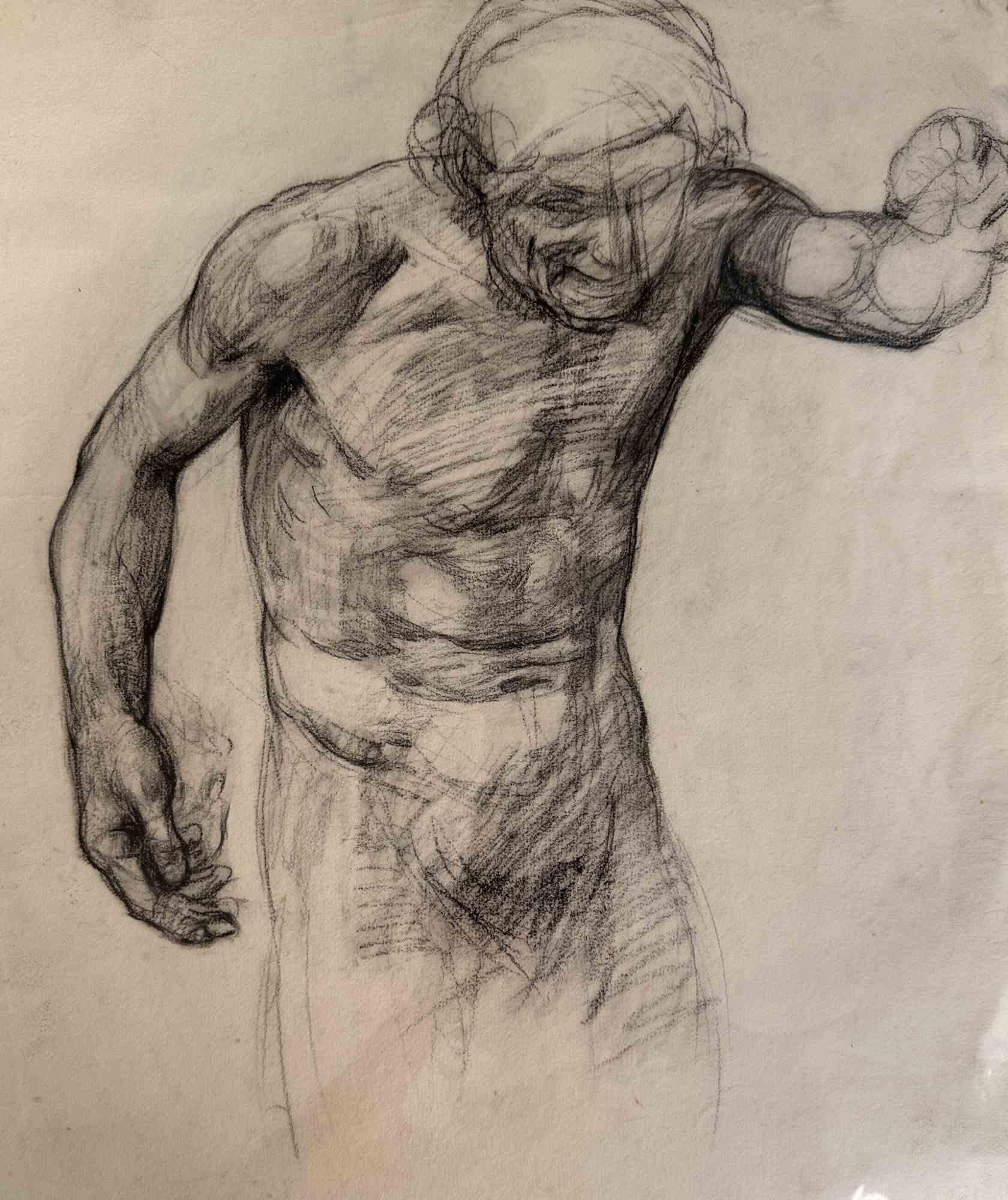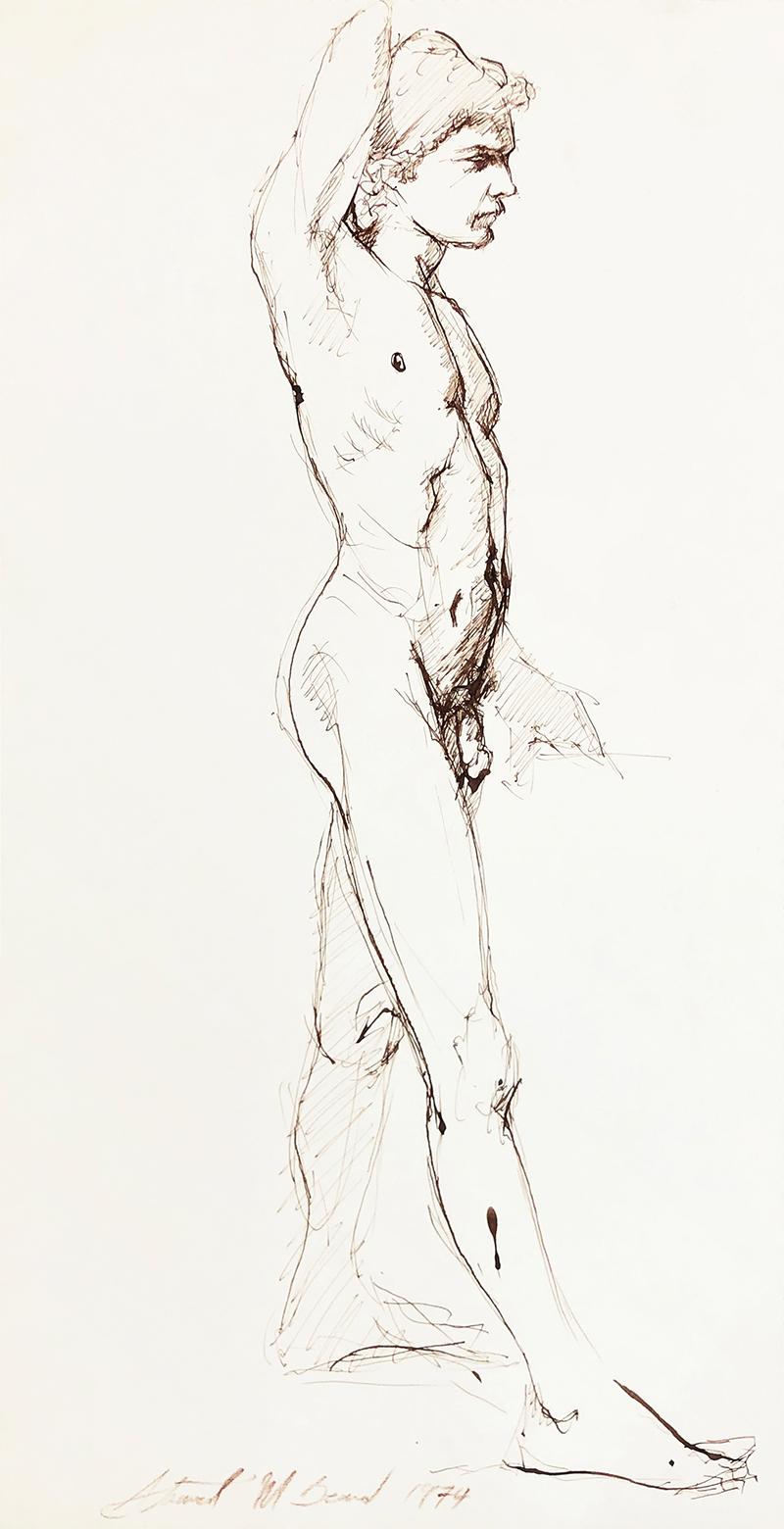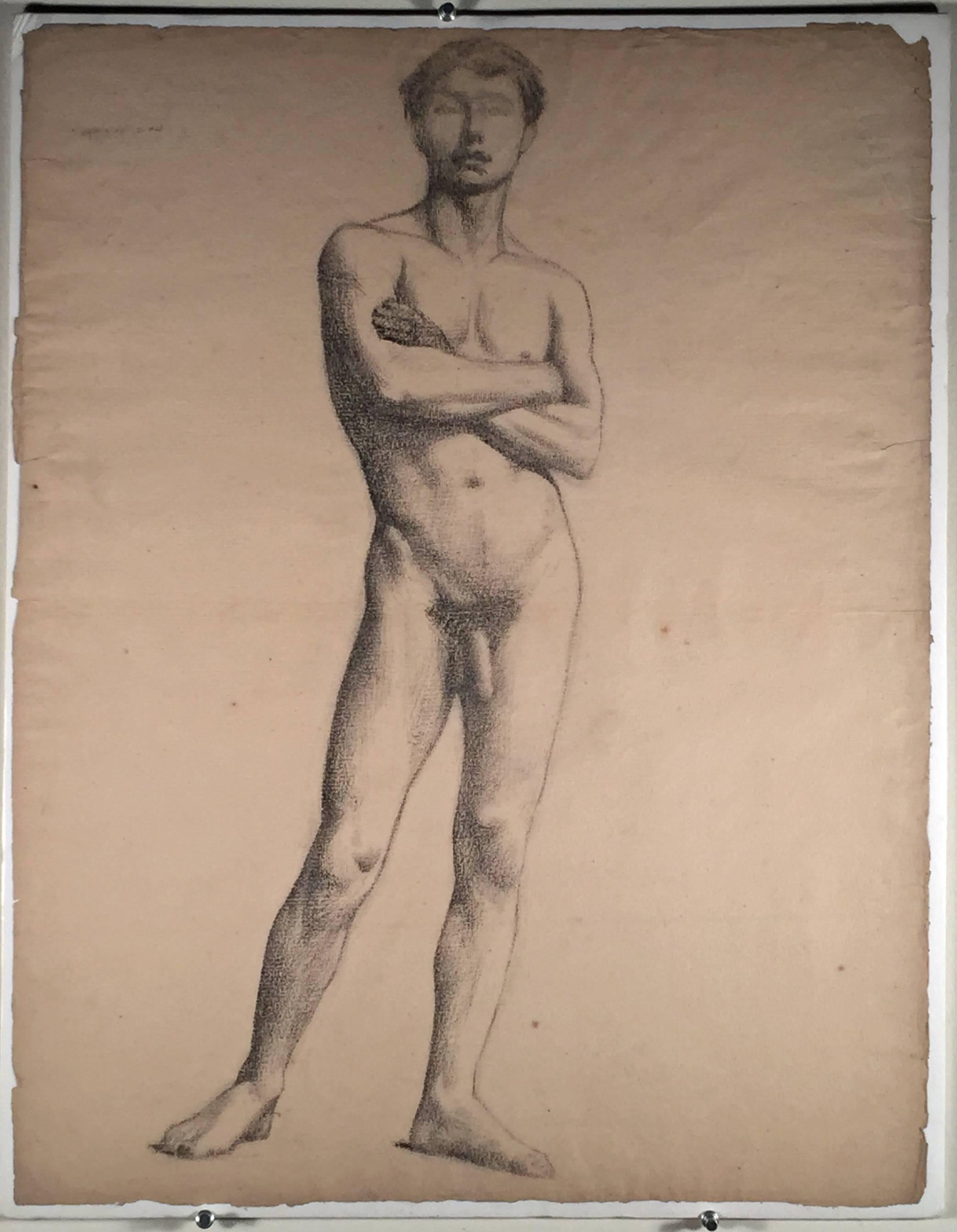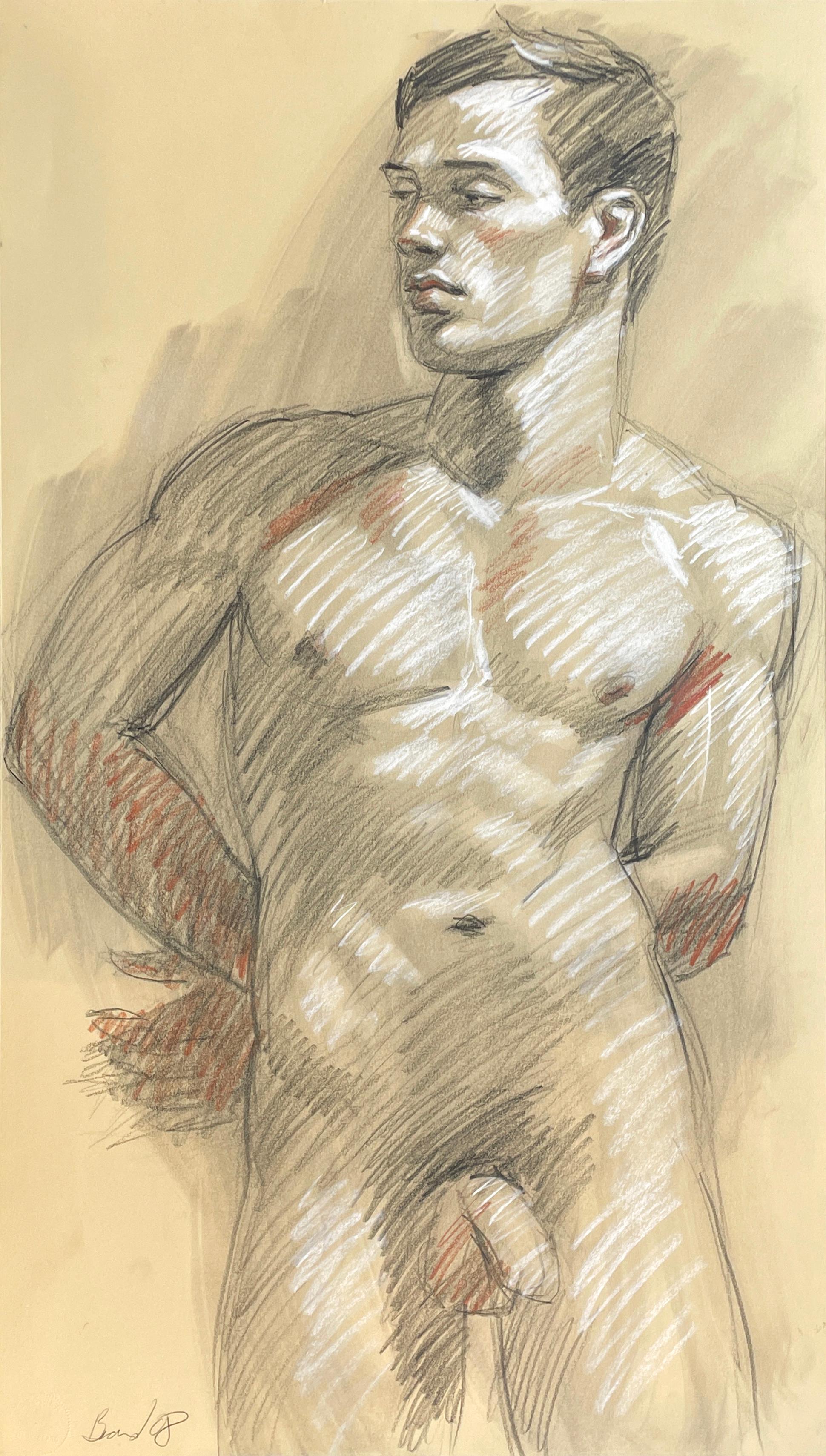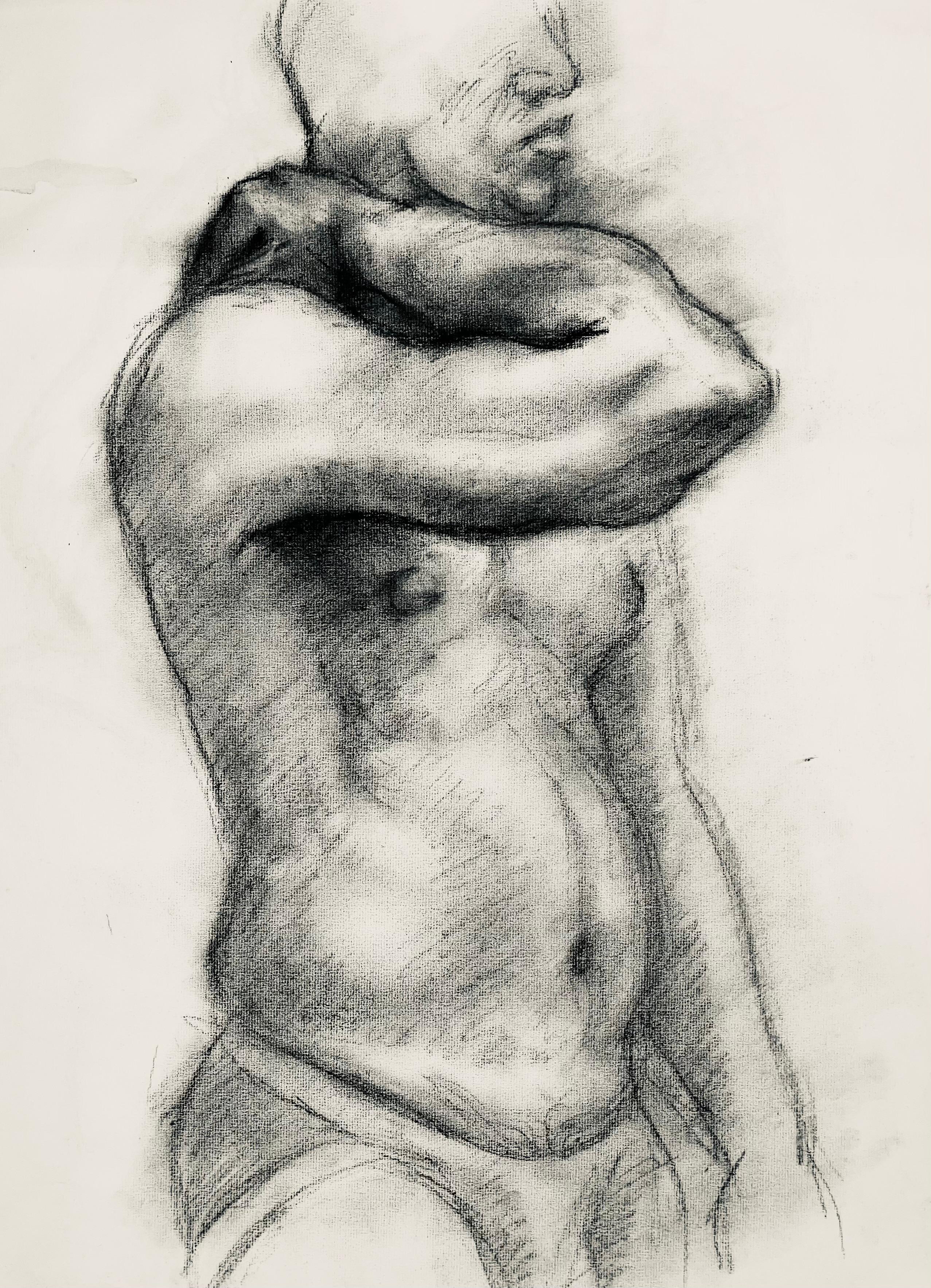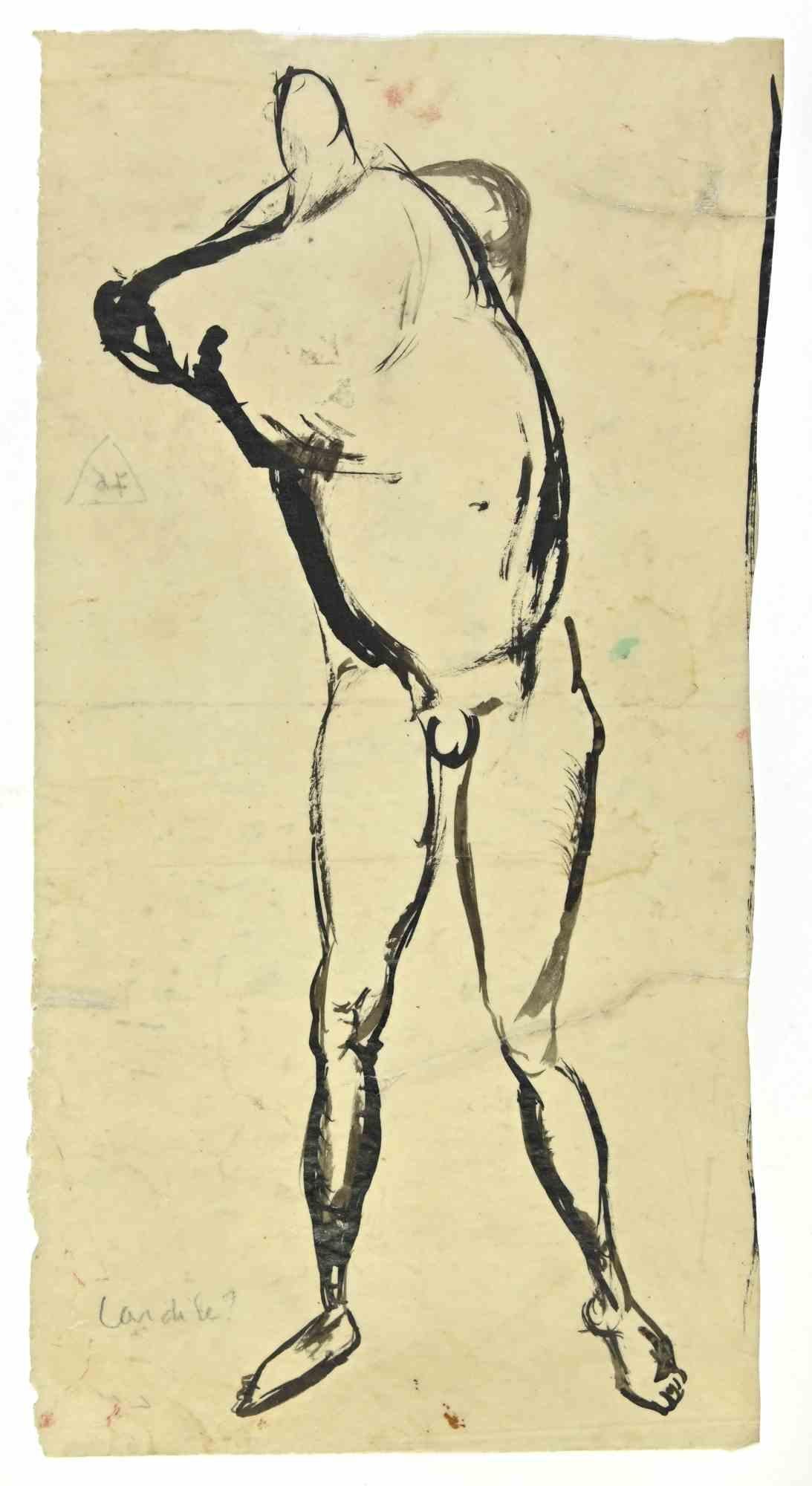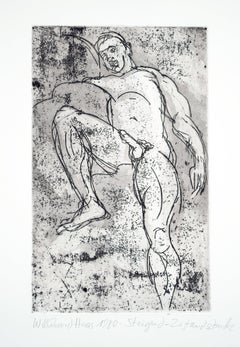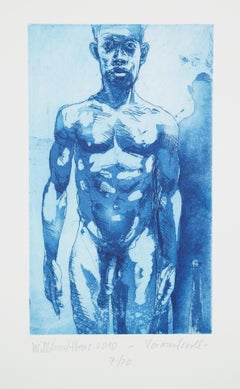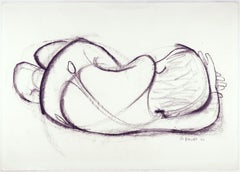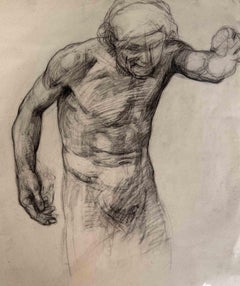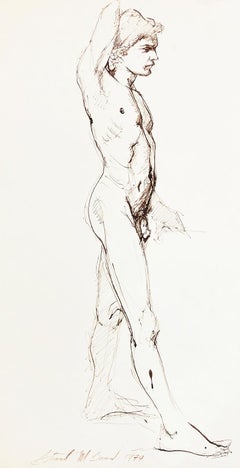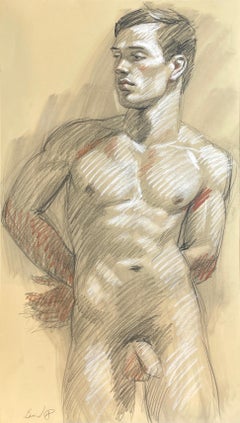Items Similar to Self-portrait - Homo nudus -
Want more images or videos?
Request additional images or videos from the seller
1 of 8
Bruno PaulSelf-portrait - Homo nudus -1895
1895
$3,328.16
$4,160.1920% Off
£2,478.44
£3,098.0520% Off
€2,800
€3,50020% Off
CA$4,594.97
CA$5,743.7120% Off
A$5,094.20
A$6,367.7520% Off
CHF 2,677.20
CHF 3,346.5020% Off
MX$62,344.67
MX$77,930.8420% Off
NOK 33,435.52
NOK 41,794.4120% Off
SEK 31,382.59
SEK 39,228.2320% Off
DKK 21,318.27
DKK 26,647.8320% Off
About the Item
Bruno Paul (1874 Seifhennersdorf - 1968 Berlin). Self-portrait, c. 1895. Pencil on paper, mounted on cardboard, 53.5 x 35 cm, signed 'Paul' at upper left.
- Homo nudus -
About the artwork
In a mirrored situation, Bruno Paul looks at himself in the picture. While his body, which is the size of the format, is shown in profile parallel to the picture, he turns his head into the picture in order to become aware of himself there, whereby the lighter use of the drawing tool indicates that this is another level of reality - a mirror image, to be precise. The encounter with himself is a sober introspection of his own 'naked actuality'. A stock-taking beyond academic idealisation, whose point of departure and destination is the realisation addressed simultaneously to the observer: "I am what I am". And one's own form of existence is certainly deformed, which becomes particularly apparent when Paul portrays himself in the final position, directly challenging an academic view of the body. Piquantly, he has made this self-exploration on the inside cover of a portfolio of embroidered representations that serve as models for the study of fine forms of beauty.
Despite the realism of an unadorned, truthful self-portrait, there is an inscrutability. The sitter remains hidden from himself, as evidenced by the distanced gaze of self-observation. Accordingly, one half of the sitter's face appears to be erased in the mirror image.
Here Bruno Paul creates a self-portrait that is unique in his oeuvre and that, in the form of a pictorial self-reflection, poignantly illustrates the experience of self-alienation in modernity.
Alfred Ziffer (ed.): Bruno Paul. Deutsche Raumkunst und Architektur zwischen Jugendstil und Moderne, Münchner Stadtmuseum, Munich 1992, cat. No. 5, p. 26. There identified as a "Male Nude" of 1894/95.
About the artist
Bruno Paul's talent for drawing led him to study at the 'Kunstgewerbeschule' in Dresden from 1890 to 1893, while working as a draughtsman. From 1894 Paul studied under Paul Höcker at the Academy of Fine Arts, while also attending lectures at the Technical University. Between 1896 and 1900 he contributed graphic illustrations to the magazine 'Jugend' and between 1897 and 1906 numerous illustrations to the magazine 'Simplicissimus'. He also produced book illustrations and exhibition posters.
In 1898, together with Bernhard Pankok, Richard Riemerschmid and Hermann Obrist, he founded the 'Münchner Vereinigte Werkstätten für Kunst im Handwerk', designing furniture, textiles, wallpaper, carpets and metalwork. Paul was also one of the founding members of the 'Münchner Vereinigung für angewandte Kunst', established in 1903, whose aims anticipated those of the 'Deutscher Werkbund', of which Paul was also a co-founder.
The prizes Paul received for interior design in Paris (1900), St Louis (1904) and Dresden (1906) led to his appointment in 1907 as head of the teaching department at the Museum of Decorative Arts in Berlin, which Wilhelm von Bode secured against Kaiser Wilhelm II, despite Paul's earlier caricatures in Simplicissimus. With the construction and lavish furnishing of 'Haus Westend' for the director of the Berlin branch of the Vereinigte Werkstätten in 1908, Paul became a sought-after architect among the Berlin bourgeoisie, who also commissioned him to furnish ships of the Norddeutscher Lloyd. From 1907 to 1908 Ludwig Mies van der Rohe and from 1909 to 1910 the future Bauhaus architect Adolf Meyer worked in Bruno Paul's office.
In 1908 Paul developed the first 'Type Furniture Programme' and in 1911 the 'Series Furniture', which was produced at the Deutsche Werkstätten in Dresden-Hellerau until 1942. In 1910 Paul was entrusted with the artistic direction of the German section at the World Exhibition in Brussels. After his admission to the Prussian Academy of Arts in 1919, Paul focused his reform efforts increasingly on the field of state art education and published the programmatic paper 'Erziehung der Künstler an staatlichen Schulen'.
In 1924, he brought about the unification of the Unterrichtsanstalt and the Hochschule der bildenden Künste to form the Vereinigte Staatsschule für freie und angewandte Kunst - today's Universität der Künste Berlin. In 1925, Paul acquired the Richmodishaus in Cologne and founded the Vereinigte Zoo-Werkstätten in Berlin, initially producing lamps and later furniture. After international successes that consolidated Paul's leading role in the field of artistic interior design, he was forced to resign when the Nazis seized power. Together with Ernst Barlach, Ernst Ludwig Kirchner, Ludwig Mies van der Rohe and Emil Rudolf Weiß, he was expelled from the Academy in 1937 for being "politically unreliable". Despite this, Paul was held in high esteem by Adolf Hitler, who included him on his "Gottbegnadetenliste" (list of those blessed by God), thus saving him from war service. After the war, Paul worked as an architect on the reconstruction of Höxter and Düsseldorf. In 1948 he turned down an appointment as president of the German Academy in East Berlin. In 1955 he was reinstated by the Akademie der Künste. In 1957 he moved to Berlin, where he died in 1968 at the age of 94.
Selected Bibliography
Alfred Ziffer (Hg.): Bruno Paul. Deutsche Raumkunst und Architektur zwischen Jugendstil und Moderne, Münchner Stadtmuseum, München 1992.
Sonja Günther: Bruno Paul. 1874–1968, Berlin 1992.
Andreas Strobl; Barbara Palmbach: Bruno Paul. Simplicissimus, München 2003.
Ralph Musielski: Bau-Gespräche. Architekturvisionen von Paul Scheerbart, Bruno Taut und der "Gläsernen Kette", Berlin 2003.
GERMAN VERSION
Bruno Paul (1874 Seifhennersdorf - 1968 Berlin). Selbstporträt, um 1895. Bleistift auf Papier, auf Karton aufgezogen, 53,5 x 35 cm, links oben signiert "Paul.".
- Homo nudus -
zum Werk
In einer Spiegelsituation steht sich Bruno Paul innerhalb des Bildes selbst gegenüber. Während sein formatdurchmessender Körper in der bildparallelen Profilansicht gezeigt ist, wendet er sich mit dem Kopf ins Bild hinein, um dort seiner selbst ansichtig zu werden, wobei der leichtere Auftrag des Zeichenwerkzeugs anzeigt, dass es sich hier um eine andere Realitätsebene - eben um ein Spiegelbild - handelt. Die Selbstbegegnung ist eine nüchterne Selbstbetrachtung der eigenen 'nackten Tatsächlichkeit'. Eine Bestandsaufnahme jenseits akademischer Idealisierung, dessen Ausgangs- und Zielpunkt die zugleich an den vom Spiegelbild adressierten Betrachter gerichtete Erkenntnis ist: "Ich bin, der ich bin." Und die eigene Daseinsform weist durchaus Unförmigkeiten auf, die besonders auffällig werden, indem sich Paul in der Schlussstellung porträtiert, was eine akademische Körperbetrachtung geradewegs herausfordert. Pikanterweise hat er diese Selbsterkundung auf der Innenseites des Einbanddeckels einer Mappe für Stickerei-Darstellungen angefertigt, die als Vorlagen zum Studium feiner Schönheitsformen dienen.
Trotz der Realistik einer ungeschönt wahrhaftigen Selbstdarstellung besteht dennoch eine Unfassbarkeit. Der Porträtierte bleibt sich selbst verborgen, wovon der in der Selbstbeobachtung sich selbst gegenüber distanzierte Blick zeugt. Dementsprechend erscheint die eine Gesichtshälfte im Spiegelbild wie ausgelöscht.
Bruno Paul schafft hier ein innerhalb seines Oeuvres einzigartigen Selbstporträt, das in Form einer bildlichen Selbstreflexion auf ergreifende Weise die Erfahrung der Selbstentfremdung der Moderne veranschaulicht.
Alfred Ziffer (Hg.): Bruno Paul. Deutsche Raumkunst und Architektur zwischen Jugendstil und Moderne, Münchner Stadtmuseum, München 1992, Kat. Nr. 5, S. 26. Dort als "Männlicher Akt" von 1894/95 ausgewiesen.
zum Künstler
Aufgrund seiner zeichnerischen Begabung absolvierte Bruno Paul von 1890 bis 1893 eine Ausbildung an der Kunstgewerbeschule Dresden und nebenher ein Praktikum als Bauzeichner. Seit 1894 studierte Paul dann bei Paul Höcker an der Kunstakademie und besuchte parallel dazu Vorlesungen an der Technischen Hochschule. Zwischen 1896 und 1900 lieferte er grafische Beiträge für die „Jugend“ und von 1897 bis 1906 zahlreiche Illustrationen für den „Simplicissimus“. Daneben fertigte er Buchillustrationen und Ausstellungsplakate an.
1898 gründete er zusammen mit Bernhard Pankok, Richard Riemerschmid und Hermann Obrist die "Münchner Vereinigten Werkstätten für Kunst im Handwerk" und entwarf Möbel, Textilien, Tapeten, Teppiche und Metallarbeiten. Zudem gehörte Paul zu den Gründungsmitgliedern der 1903 in Leben gerufenen „Münchner Vereinigung für angewandte Kunst“, deren Zielsetzungen das Programm des "Deutschen Werkbundes" vorwegnahmen, zu dessen Initiatoren Paul ebenfalls gehörte.
Die Auszeichnungen für Raumausstattungen, die Paul in Paris (1900), St. Louis (1904) und Dresden (1906) zu teil wurden, führten 1907 zu seiner Berufung als Leiter der Unterrichtsanstalt am Kunstgewerbemuseum in Berlin, die Wilhelm von Bode, trotz Pauls früherer Karikaturen im Simplicissimus, gegen Kaiser Wilhelm II. durchsetzte. Mit dem Bau und der aufwendigen Ausstattung von „Haus Westend“ für den Direktor der Berliner Filiale der Vereinigten Werkstätten 1908 wurde Paul zum gefragten Architekten des Berliner Großbürgertums, der auch für die Ausstattung von Schiffen der Norddeutschen Lloyd herangezogen wurde. Von 1907 bis 1908 war Ludwig Mies van der Rohe und zwischen 1909 und 1910 der spätere Bauhausarchitekt Adolf Meyer im Architekturbüro Bruno Pauls tätig.
1908 entwickelte Paul das erste „Typenmöbel-Programm“ und 1911 die „Serien-Möbel“, die bis 1942 an den Deutschen Werkstätten in Dresden-Hellerau hergestellt wurden. 1910 wurde Paul mit der künstlerischen Leitung der Deutschen Abteilung auf der Weltausstellung in Brüssel betraut. Nach seiner Aufnahme in die Preußische Akademie der Künste, 1919, verlegte Paul seine Reformbemühungen verstärkt in den Bereich der staatlichen Kunstausbildung und gab die programmatische Schrift „Erziehung der Künstler an staatlichen Schulen“ heraus. 1924 erwirkte er die Vereinigung der Unterrichtsanstalt und der Hochschule der bildenden Künste zur „Vereinigten Staatsschule für freie und angewandte Kunst“ - die heutige Universität der Künste Berlin.
1925 erwarb Paul das „Richmodishaus“ in Köln und richtete in Berlin die „Vereinigten Zoo-Werkstätten“ ein, die zunächst Lampen und später auch Möbel herstellten. Nach internationalen Erfolgen, die Pauls führende Rolle auf dem Gebiet der künstlerischen Wohngestaltung befestigten, musste er mit der Machtergreifung der Nationalsozialisten sein Amt niederlegen. 1937 wurde er zusammen mit Ernst Barlach, Ernst Ludwig Kirchner, Ludwig Mies van der Rohe und Emil Rudolf Weiß als "politisch unzuverlässig" aus der Kunstakademie ausgeschlossen. Dennoch wurde Paul von Adolf Hitler geschätzt, der Paul in dessen "Gottbegnadeten-Liste" aufnahm, was ihn vor einem Kriegseinsatz bewahrte. Nach dem Krieg betätigte sich Paul in Höxter und Düsseldorf als Architekt am Wiederaufbau. Die Berufung zum Präsident der Deutschen Akademie in Berlin-Ost 1948 lehnte er ab. 1955 wurde er von der Akademie der Künste rehabilitiert. 1957 übersiedelte er nach Berlin, wo er 1968 im Alter von 94 Jahren starb.
Auswahlbibliographie
Alfred Ziffer (Hg.): Bruno Paul. Deutsche Raumkunst und Architektur zwischen Jugendstil und Moderne, Münchner Stadtmuseum, München 1992.
Sonja Günther: Bruno Paul. 1874–1968, Berlin 1992.
Andreas Strobl; Barbara Palmbach: Bruno Paul. Simplicissimus, München 2003.
Ralph Musielski: Bau-Gespräche. Architekturvisionen von Paul Scheerbart, Bruno Taut und der "Gläsernen Kette", Berlin 2003.

About the Seller
5.0
Vetted Professional Seller
Every seller passes strict standards for authenticity and reliability
Established in 2014
1stDibs seller since 2023
21 sales on 1stDibs
- ShippingRetrieving quote...Shipping from: Berlin, Germany
- Return Policy
Authenticity Guarantee
In the unlikely event there’s an issue with an item’s authenticity, contact us within 1 year for a full refund. DetailsMoney-Back Guarantee
If your item is not as described, is damaged in transit, or does not arrive, contact us within 7 days for a full refund. Details24-Hour Cancellation
You have a 24-hour grace period in which to reconsider your purchase, with no questions asked.Vetted Professional Sellers
Our world-class sellers must adhere to strict standards for service and quality, maintaining the integrity of our listings.Price-Match Guarantee
If you find that a seller listed the same item for a lower price elsewhere, we’ll match it.Trusted Global Delivery
Our best-in-class carrier network provides specialized shipping options worldwide, including custom delivery.More From This Seller
View AllRising
Located in Berlin, DE
Willibrord Haas (*1936 Schramberg), Rising, 1980. Etching, 35 cm x 22 cm (plate size), 53.5 cm x 38 cm (sheet size). Signed “Willibrord Haas” in pencil by the artist, dated “1980”, t...
Category
1980s Realist Nude Prints
Materials
Paper
Reproachful
Located in Berlin, DE
Willibrord Haas (*1936 Schramberg), Reproachful, 2010. etching, 33.5 cm x 20 cm (plate size), 54 cm x 37.5 cm (sheet size). Signed “Willibrord Haas” in lead by the artist, dated “201...
Category
2010s Realist Nude Prints
Materials
Paper
The completely naked prostration
Located in Berlin, DE
Willibrord Haas (*1936 Schramberg), The completely naked prostration, 1999. Etching, 32.5 cm x 23.5 cm (plate size), 54 cm x 37.5 cm (sheet size). Signed “Willibrord Haas” in lead by...
Category
1990s Realist Nude Prints
Materials
Paper
Lying Boy / - Fragile childlikeness -
Located in Berlin, DE
Alfred Fuchs (1925 Saarbrücken - 2003 Prague), Lying Boy. Charcoal drawing on strong paper, 30 x 41.5 cm, signed A.[lfred] Fuchs and dated [19]96.
- smal...
Category
1990s Realist Figurative Drawings and Watercolors
Materials
Charcoal
$523 Sale Price
20% Off
Entangled
Located in Berlin, DE
Willibrord Haas (*1936 Schramberg), Entangled, 2008. etching, 28 cm (height) x 17 cm (width). Signed “Willibrord Haas” in pencil by the artist, dated “2008”, titled “Verschränkt” and...
Category
Early 2000s Realist Nude Prints
Materials
Paper
Access
Located in Berlin, DE
Willibrord Haas (*1936 Schramberg), Access, 1979. etching, 40 cm x 30 cm (plate size), 54 cm x 37.5 cm (sheet size). Signed “Willibrord Haas” in pencil by the artist, dated “1979”, t...
Category
1970s Realist Nude Prints
Materials
Paper
You May Also Like
Body of Man - Drawing - Mid-20th century
Located in Roma, IT
Body of Man is a drawing realized by an Anonymous artist in the mid-20th century.
Charcoal on paper. With another drawing of hands in the rear.
Good...
Category
Mid-20th Century Modern Figurative Drawings and Watercolors
Materials
Paper, Charcoal
Untitled (Standing Male Nude Facing Right)
By Mark Beard
Located in New York, NY
Ink on paper
Signed and dated, l.c.
This artwork is offered by ClampArt, located in New York City.
Mark Beard, born in 1956 in Salt Lake City, now...
Category
1970s Realist Figurative Drawings and Watercolors
Materials
Paper, Ink
ACADEMIC MALE NUDE FIGURE STUDIES
Located in Portland, ME
Michallet (attributed). ACADEMIC MALE NUDE FIGURE STUDIES. Four Charcoal drawings, each on heavy wove paper, 19th Century. 24 1/2 x 19 1/8 inches (s...
Category
Mid-19th Century Academic Figurative Drawings and Watercolors
Materials
Charcoal
MB 023 (Figurative Life Drawing of Handsome Male Nude by Mark Beard)
By Mark Beard
Located in Hudson, NY
Academic life drawing of male nude with charcoal and graphite by Mark Beard, "MB 023"
graphite, Conte crayon and charcoal on Arches paper
30.5 x 17.5 inches unframed
Signed, lower le...
Category
2010s Contemporary Figurative Drawings and Watercolors
Materials
Conté, Charcoal, Archival Paper, Graphite
Renaissance Male Figure Study, 1963, Ian Hornak — Drawing
By Ian Hornak
Located in Fairfield, CT
Artist: Ian Hornak (1944-2002)
Title: Renaissance Male Nude Study
Year: circa 1963
Medium: Original drawing on vélin paper
Size: 23 x 18 inches
Condition: Good
Provenance: Estate of ...
Category
1960s Renaissance Figurative Drawings and Watercolors
Materials
Charcoal
$2,200 Sale Price
20% Off
Posing Male Nude - Drawing - Mid 20th century
Located in Roma, IT
Posing Male Nude is a drawing artwork realized by an Anonymous artist in the mid-20th century.
Black ink on paper.
Signed by the artist, illegible.
Good conditions and aged.
Category
Mid-20th Century Modern Figurative Drawings and Watercolors
Materials
Ink
More Ways To Browse
1895 Antiques
Paul Berlin
Antique Painting Tools
Hitler Painting
Hitler Signed
Antique Drawing Tools
Nude Male Self Portraits
Dior Fur Hat
Academic Male Nude
Paul Bruno
East German Lamp
Antique Level Tool
Academic Male Nude Paintings
Academic Drawing Male Nude
Weiss Artwork
Cat In The Hat
Fur Hat Used
Antique German Lighter
